Without a content marketing funnel, you can’t effectively guide people from simply being aware your brand exists, to finally making a purchase.
Building an effective funnel requires a solid understanding of your audiences needs and how your content marketing efforts can provide value based on those needs—which is a lot easier said than done, but incredibly worth it.
See also: How to Create an Effective Content Marketing Strategy
It’s vital to your business, and will provide a foundation for attributing an impact in revenue to your content marketing efforts—something most content marketers have trouble with today. In fact, according to Optinmonster, 62% of marketers don’t know how to measure the ROI of their content marketing campaigns.
But once you’ve built your content marketing funnel, this gets a whole lot easier. Not to mention, you’ll be able to squash the rumor that content is only reserved for top of the funnel marketing efforts.
What is a Content Marketing Funnel?
A content marketing funnel goes by many names, sometimes referred to as a ‘content funnel’ or a ‘content marketing sales funnel,’ but they’re all essentially the same thing.
A content marketing funnel is a documented strategy for moving people from simply being aware of your brand to making a purchase, using different types of content and distribution tactics to reach them at all stages of their buyer journey.
Like all funnels, a content marketing funnel has four main parts:
- Top of the funnel (TOFU) —> Awareness stage
- Middle of the funnel (MOFU) —> Consideration stage
- Bottom of the funnel (BOFU) —> Decision stage
- Customer retention
This fun visual from Moz likens the content marketing funnel to a drip coffee pot:

Eventually, we’ll fill each of these funnel stages with audience information and content types to suit that audience, all of which will align with your content marketing strategy.
How to Build a Successful Marketing Funnel
Content marketing funnels, like all funnels, are not one-size fits all. Yours will have to fit your audience’s needs for it to work.
So, how does a marketing funnel work, and how do you create one for your audience?
To achieve full funnel content marketing, start by asking yourself these questions:
- Who is your target customer, or customers? The answer to this question should e detailed, and include information like demographic, education levels, income, job titles and more.
- What challenges are they facing (that you can solve)? How do you and your product fit into their story organically?
- Where are they online today? If you’re selling B2B software, LinkedIn may be a good place to learn more about your demographic, whereas if you’re selling home goods, Instagram might be a better place to start.
- What stages does my target customer go through before they make a purchase? This boils down to whether or not your funnel is short or long, and how many steps you need to nurture before a prospect makes it to purchase.
This content marketing funnel template from Buzzsumo walks you through some of these questions, and even structures how you delegate each of your tasks:
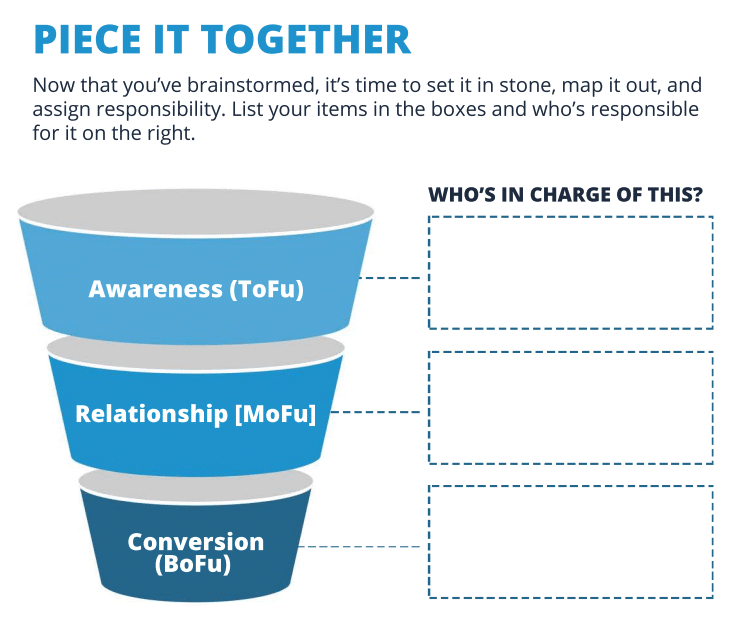
While I don’t subscribe to assigning content types to each funnel stages (I believe a case study can be just as useful for awareness as it can be for decision, if it’s presented correctly), some content types are used more often in certain stages of the funnel than others, and for good reason.
Let’s go through which types of content marketing are most used in each stage of the funnel.
1. Awareness
In this stage of your funnel, you’re getting to know new potential customers for the first time and are in the process of convincing them that your product is one they should consider.
We’ll go through content marketing examples at each stage, as well as tips and best practices for effective execution.
Blog Posts
In my experience, when most people break into content marketing for the first time, they start with a blog. That’s usually because it’s the easiest type of content to get up and running, and it’s a great foundation for getting users to know you.
At the awareness stage, your blog articles should do the following:
- Answer your potential customer’s most burning questions
- Host provocative opinion pieces from your company’s executive team, positioning you as thought leaders in your industry
- Host content created specifically to target search terms that allow your audience to organically find you
For example, this recent piece from Evernote solves a problem for their potential customers—how to turn their ideas into action.
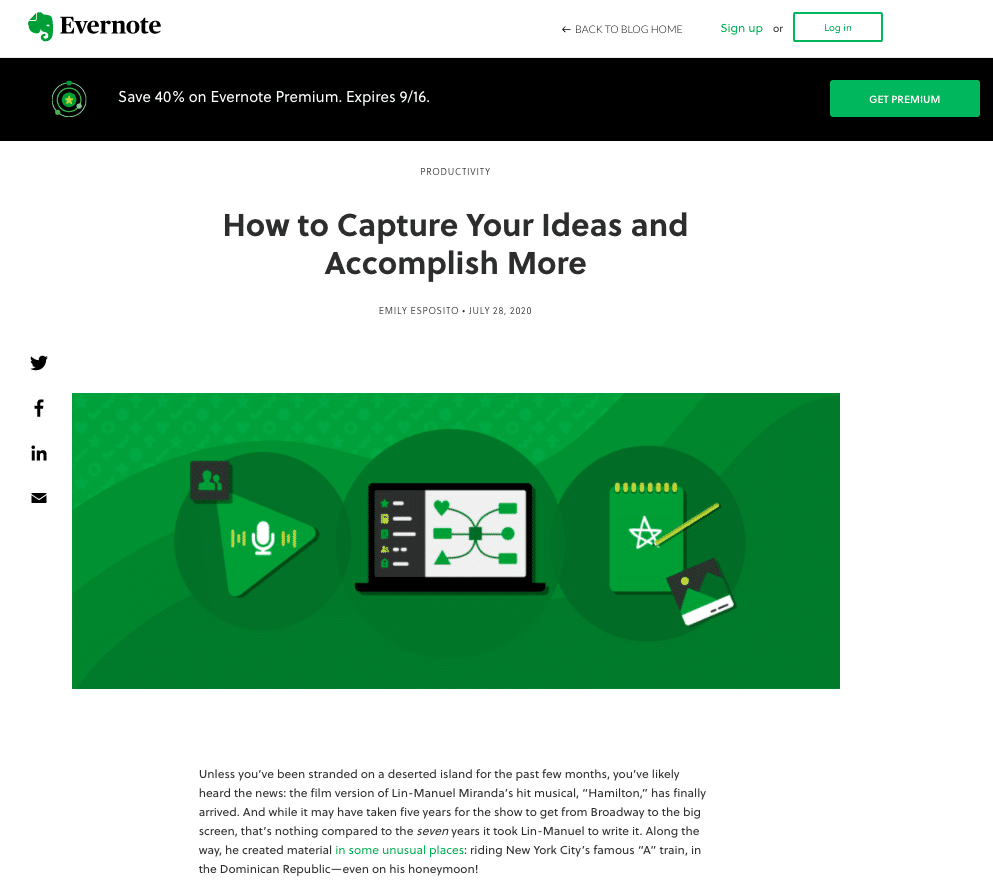
Big Content
Moz lovingly deemed this category of content ‘big content,’ which is fitting, because it’s usually a big project for your team to get live. This type of content includes things like the development of online branded games, tools, long-form content, and micro-sites.
This type of content is built to get a lot of attention, pickup in the press, or social shares, with the goal of getting as many people familiar with your brand as possible. At the awareness stage, your big content should do the following:
- Get press attention
- Create a increase in social sharing
- Create an increase in social mentions and positive sentiment posts for your brand
Seer Interactive is a well-known marketing agency. They created this interactive tool for potential customers to browse how some of the top advertising platforms make their money. This tool allowed them to position themselves as thought leaders and have customers interact with their brand.

Comprehensive Guides
Guides can take many shapes and forms, but typically cover a big topic in detail for interested consumers. Fashion brands might release a ‘Fall Fashion Guide,’ or education brands might want to produce a ‘Back-to-School Guide.’ These can take the form of videos, blog posts, interactive content, and much more, but are typically long-form and quite detailed.
At the awareness stage, your guides should:
- Provide thorough, detailed information for your target customer to solve a pressing problem they’re having
- Host ample opportunities for visitors to convert in some way—like make a purchase, contact you, subscribe to a newsletter or download a gated asset.
HubSpot‘s guide to inbound marketing is an important flagship piece for them to position themselves as a continued thought leader in their industry.
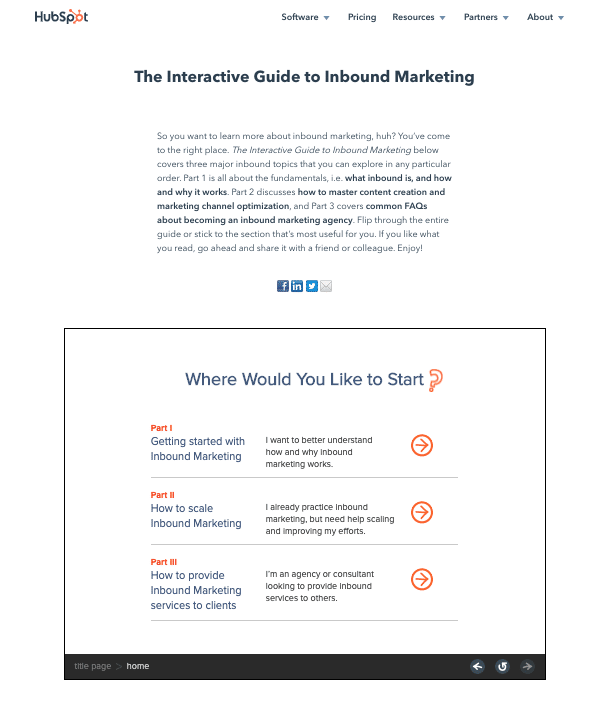
Videos
Short, entertaining video content can do a lot of good for your awareness efforts. H&M’s guest designer collaborations feature designers outside of the H&M family and playfully walk customers through how to style some of the pieces they sell.
Videos at the awareness stage should:
- Be short, snappy and entertaining
- Be clear that they came from your brand, without selling
- Be shareable and lively
Even if you’re not yet an H&M customer, these videos are informative and shareable. I really liked this example with Versace:
Email Newsletters
Emails can fall throughout the funnel, depending on their content and their purpose. Email newsletters however, typically exist to share content to those who have subscribed to updates from your blog or other channels, and exist solely to provide value for your brand’s audience.
In fact, they’re a great way to move potential customers from the awareness stage to the consideration stage, by sharing gated content, case studies, webinars, and other types of content that we’ll talk about in the next section.
Newsletters at the awareness stage should:
- Only share content that provides value to your audience
- Be entertaining, and something your subscribers will look forward to opening
- Provide opportunities for subscribers to move to the consideration stage
I love Robinhood‘s email newsletters—they’re informative, snappy, and make me smarter about the finance space, without overtly selling their investment platform.
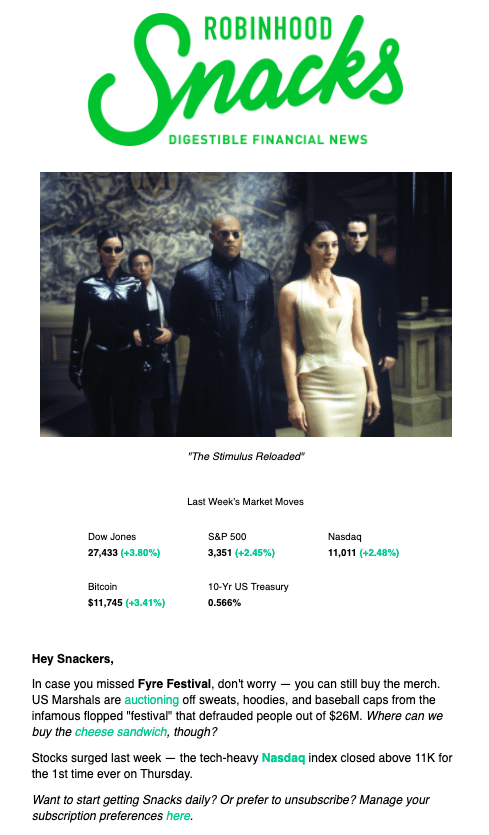
2. Consideration
At the consideration stage, consumers know your brand, but they might not be sure that you’re the best choice for them. They’re considering you, but possible also other options. Here are the types of content that help those considering you decide that they should purchase.
Gated Content
Gated content is anything that sits behind a form. This can include content like E-books, reports, whitepapers, and webinars. They’re great tools for converting users from the awareness stage to the consideration stage, as consumers are typically willing to trade more personal information in order to have access to them.
Think about gated content in contrast to a blog subscriber, social media follower or website visitor. They don’t leave much information behind. Gated content provides you with the opportunity to capture their email address and other forms of detailed information relevant to your qualifying process.
Gated content should:
- Provide unique, valuable and entertaining insight to consumers
- Be valuable enough that a consumer is willing to trade his or her email address for that content
- Provide multiple opportunities for that consumer to convert to the next stage of the funnel.
One of my favorite examples is Velocity Partners’ B2B Marketing Manifesto—it’s informative, detailed and provides a ton of valuable insight for B2B marketers.

How-To Content, Showcasing Your Product
Some customers might not be sure whether you’re the right choice for them because they haven’t seen your product in action. Showing them exactly how it can be used could help move them through the funnel.
Your how-to content should:
- Showcase your product at it’s best
- Clearly present how it can be used (and if it can be used in multiple scenarios, show how)
- Provide a clear call-to-action to purchase that product
Lowe’s has a dedicated section of their website for how-to content that shows potential customers how to complete home do-it-yourself (DIY) projects using their products.
This guide on how to install a hard wood floor includes a materials guide, a video and step-by-step written instructions for potential customers.

Demo videos
I like to think of demo videos as a middle ground between a commercial and a how-to video. The information you’re providing about your product is a bit more concrete than a commercial, but it’s not quite so detailed as a how-to video.
Demo videos are typically more popular in the B2B space, and should do the following:
- Walk potential customers through your product features
- Showcase different functionality
- Clearly communicate value, ease of use, and potential
Github’s Demo Days series showcases different video demos to teach users how to best interact in their community.
3. Decision
At the decision stage, customers know they want your product, but they might need a reminder to purchase or a final push over the edge.
Case studies and Testimonials
The best type of content at the decision stage doesn’t come from you at all—it comes from people who have already purchased your product. Case studies and testimonials are a great way to convince those at the bottom of your funnel to take the final step to becoming a customer.
Case studies should:
- Showcase the customer’s voice, yours should take a back seat
- Include proof of success
- Follow a traditional story arc—start with the customer’s problem, agitate their problem, solve it, and explain how you did it.
This example from Greenhouse.io showcases human resources (HR) professionals discussing how Greenhouse.io has made their recruitment processes easier.
Different from case studies and testimonials, reviews aren’t typically something you generate yourself, but are rather user-generated-content (USG) that can have an immense impact on your buying cycle.
Reviews typically include the following:
- Trustworthy reports from people who have purchased your product
- Photos and videos of what your product might actually look like in real life
- A rating, which is particularly important for visibility on e-commerce platforms like Amazon or review sites like Yelp.
The best strategy to tackle customer reviews as a brand is to actively respond to reviews and quickly correct any mistakes for unhappy customers. This Twitter thread with Jet Blue showcases how they responded to a customer having a hard time with their booking process:
@JetBlue I have been trying to book a flight for an hour.. multiple error messages due to technical difficulties. This causes me to have to start from scratch and the price is increasing.
— KP (@CantGetATxtBack) August 19, 2020
4. Retention
Your job’s not done once the customer has made a purchase—certain types of content can keep them coming back again and again.
Help Documentation
Use your blog, help center, email flows or videos to create helpful content so customers who’ve already purchased your product can get more use out of them.
Help documentation should do the following:
- Answer common questions from your customers upfront
- Provide easy solutions for them to overcome any problems they may have encountered using your product.
LinkedIn’s help center for Lynda.com provides quick and easy answers to common customer questions in an easily digestible manner:
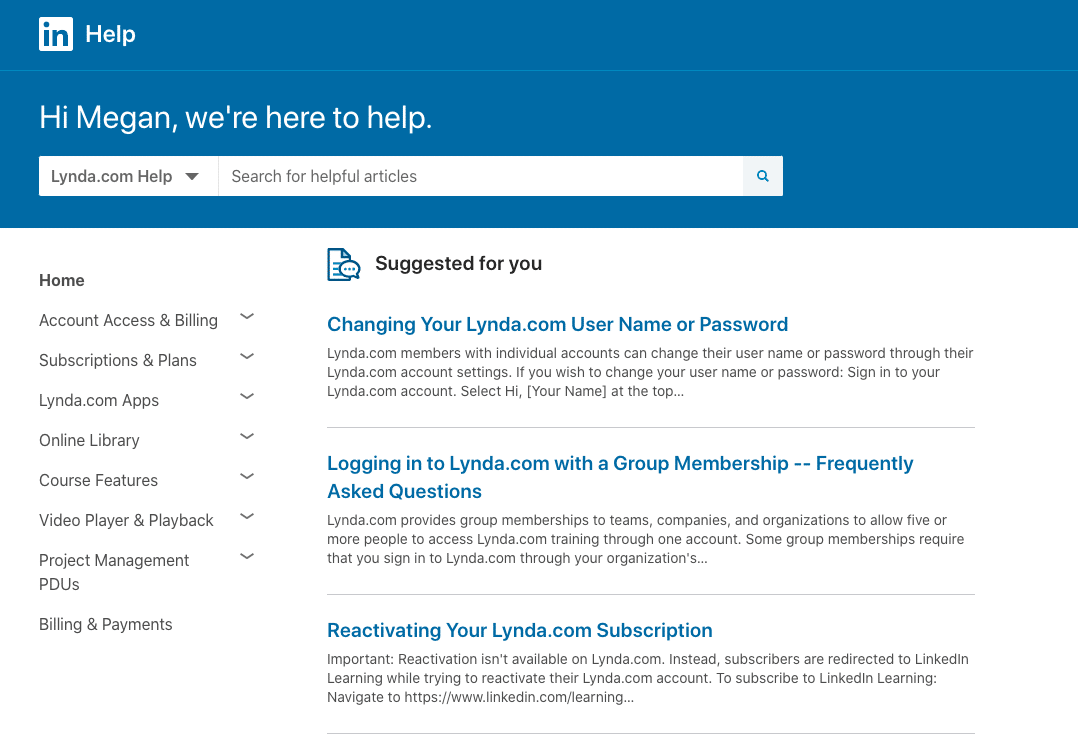
Email Outreach and Follow-Up
Use email to provide insights and tips for your customers to use your products even better. This type of email outreach typically consists of new products, special offers, product updates (if applicable), new ways to contact you for more business, and more.
Email updates should:
- Be very relevant to customer’s needs or tastes
- Include valuable information that would encourage them to stay a customer or make another purchase
- Not be too frequent or easily be considered spam
I particularly like these updates from Barnes & Noble that provide me with new and notable books each month—something I gladly scan as a frequent customer.

How to Measure the Success of a Content Marketing Funnel
Simply creating content for each stage of the buyer’s journey and pressing publish or send won’t cut it—you need a solid distribution strategy to ensure that you’re reaching each person with the right content at the right time, and a system in place to measure so you can optimize as you go.
There are many content marketing metrics to choose from, but here are some of the basics at each stage:
- Awareness
- Pageviews
- Time on site
- Video views
- Social media followers
- Social media impressions and engagement
- Blog Subscribers
- Consideration
- Form fills
- Leads generated
- Qualified leads
- Decision
- Sales qualifies leads
- Purchases or sales
If you aren’t hitting your goals (which you likely won’t when you first get started), you’ll want to perform a funnel analysis, and work on a content optimization strategy until you get the results you’re looking for.
Create a Content Marketing Funnel for Your Business
There are many benefits to creating a content marketing funnel, but its importance lies in with content marketing’s ability to drive more conversions at each stage of your buyer’s journey, all while providing value instead of a hard sell.
To summarize, here’s a short breakdown of each stage of the funnel and the types of content you might find valuable there for your brand:
- Awareness: consumers are just getting to know you, so reach them with blogs, videos, email newsletters and guides.
- Consideration: consumers know your product but might be considering competitors, so reach them with how-to-guides, demos, and gated content.
- Decision: consumers know they want to purchase but haven’t yet, so reach them with case studies, testimonials and good product reviews.
- Retention: once they’ve become your customer, nurture consumers with email updates and help documentation.
The B2B Content Marketing Funnel
It’s important to have a B2B content marketing funnel because B2B strategy can look a bit different from that of B2C. Content marketing is typically very important to B2B organizations because the buyer journey is much longer. This group is spending more time on content marketing than ever—Databox found that 40% of B2B marketers will spend more time and money on content marketing in 2020.
When it comes to the funnel though, there’s only one major difference:
A B2B content marketing funnel is the same as a business-to-consumer (B2C) content marketing funnel, except for the fact that every stage of the funnel requires more attention—this means more content creation.
This visualization from Trackmaven shows how there are more stakeholders involved in a B2B purchase than a B2C purchase:
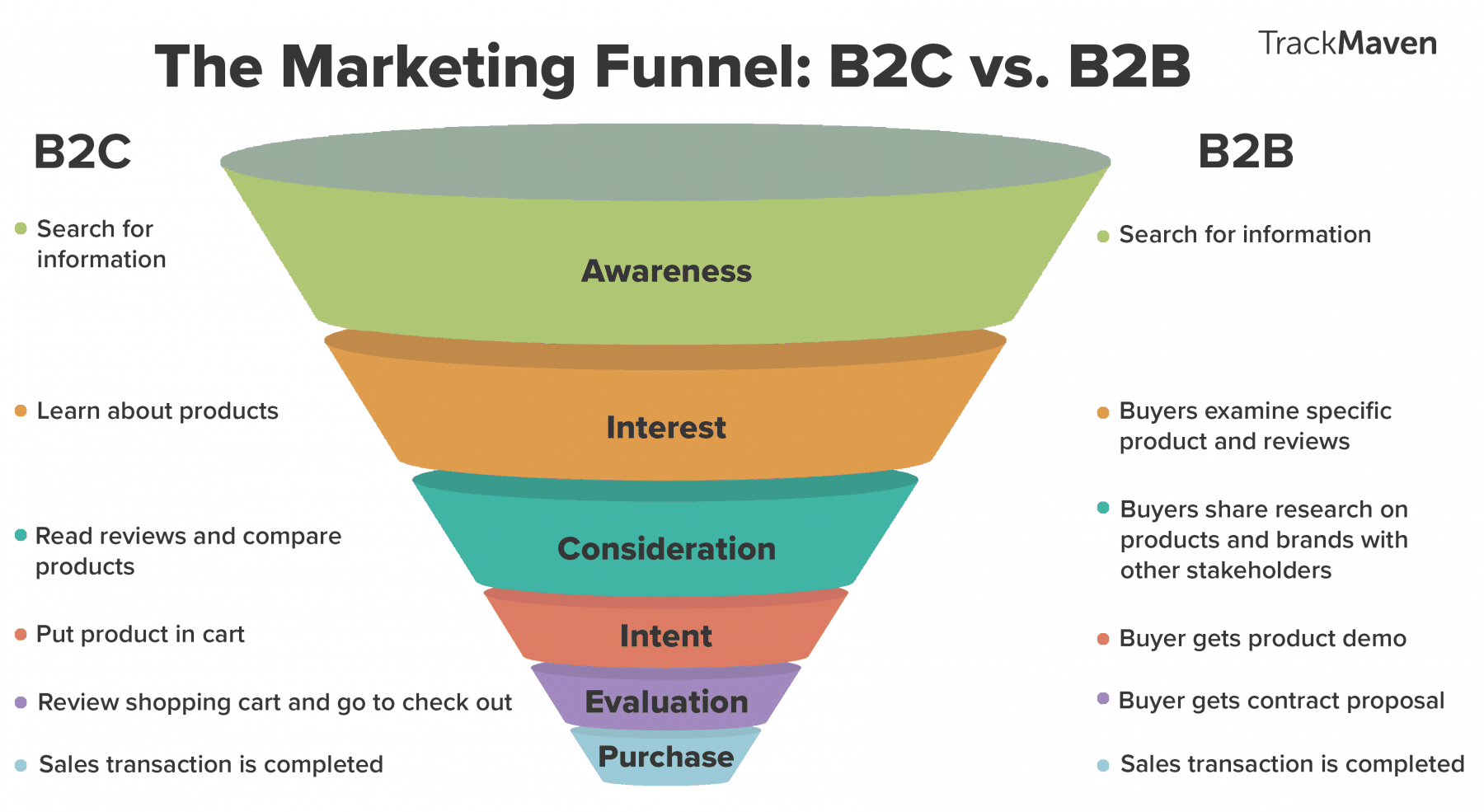
It can be more challenging to create a content marketing funnel for a B2B audience because:
- Needs are different at the account level
- You need content that speaks to every stakeholder in the process
- The decision maker changes in each organization depending on the product type
B2B content marketing statistics show that even though it may be challenging to create a funnel, it’s worth it in the end.